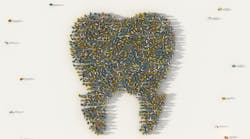What’syourrole?
Lori Trost, DMD
Marianne Dryer, MEd, RDH
Today, an increasing number of patients present with complicated medical histories, a variety of medications, the need to restore their function, and a desire for a beautiful smile. Navigating these concerns in the typical allotted appointment time, guiding their care, and successfully getting patients to accept treatment is a daily challenge. If the dentist enters the operatory and has a dissimilar message, the impact on the patient, the practice, and you can be devastating.
Unfortunately, many dental hygienists experience this type of professional detachment on a daily basis. Professional synchronization between the dental hygienist and the dentist does not come naturally in most practices. It must be cultivated.
This harmony begins with the desire to welcome crossover knowledge, understand clinical expertise of each discipline, and recognize the necessary equipment and materials to deliver optimum patient outcomes. Alongside this unified approach, each professional must become an effective communicator and be committed to discussing strategies that best fit each presentation. The ability to work in tandem to codiagnose, treatment plan, and care for patients in a mutually respected atmosphere should be intentional, calibrated, and authentic.
Illustration © Tampatra1 | Dreamstime.com
This first in a series of three articles will offer specific strategies that both the dental hygienist and dentist can implement to achieve best practice outcomes by closing the gap of intraprofessional learning, all the while growing a mutual respect for and rapport with each other.
We will better define your role, explore methods to improve communication, detail opportunities to create codiagnosis, and even relate the need and request for necessary hygiene instruments and equipment. We will advocate your position to become a copractitioner and optimize the value you bring to the practice and patients. We will demonstrate the importance of crossover knowledge with an easy-to-implement action plan.
The need to collaborate and appreciate
Fundamental to any dental practice is the need for collaboration between dental hygienist and dentist. There is so much to learn from each other, and while this professional integration is tangible, sadly it is seldom realized.
Perhaps the assumption is the hygienist and the dentist approach patients from two different mindsets. The dentist is the “driller” and the restoratively minded “fixer,” while the hygienist is the prevention specialist striving to save every periodontium! Can you see how these perceived mindsets could collide? However, by acknowledging these different approaches, you have already agreed! The conversation can now continue from a copractitioner collaboration theme.
For example, let’s start with the Class II restoration. Do you intimately know the biggest challenges of this restoration? Do you understand all the steps it takes to execute a well-placed Class II composite restoration? Do you understand how to achieve a tight contact point with a sectional matrix system? Perhaps a bigger question would be, do you care?
Do you understand the challenges of seating a matrix band on the mesial of an upper molar on someone who has a limited opening? The assistant knows, but do you? Do you know how long it takes to get composite restorations smooth so that they have a beautiful luster? Do you know how to care for those restorations when you polish the teeth?
All of these questions are important to the dentists, so perhaps it’s important to them that you know the answers as well. How can you authentically tell the patient how great Dr. Jones is without a complete understanding of his or her clinical techniques? Or, more importantly, how difficult procedures are that he or she does so well? Taking an interest in your doctor’s clinical responsibilities and expertise will help you gain respect for what he or she does and, in turn, may encourage your dentist to have a better understanding of what you do.
You may be thinking, “My dentist doesn’t understand the complexities of what I do.” And surely, your dentist couldn’t possibly understand how difficult time management could be or how thoroughly debriding a patient with instruments or inserts that are decades old could be so hard. You may even be thinking, “I’m not even sure where he or she learned to probe . . . !” In the same vein, crossover skill recognition should be employed so mutual respect and relationship building begin in a direction toward development of a calibrated, collaborative message.
In an article published in the Journal of Dental Hygiene in 2018 titled, “General Dentists’ Perceptions of Dental Hygienists’
Professional Role: A Survey,”1 results included statements such as:
“The higher the importance dentists placed on dental hygienists’ clinical and overall contributions to their practice and their patient management skills, the more diagnostic services and therapies the dental hygienists performed. The older the dentists were, the higher they rated the importance of dental hygienists’ clinical contributions, their contributions for the provision of patient care, and the more often dental hygienists performed diagnostic and additional procedures.”
In an article published in the Journal of
Dental Education in 2018 titled, “Introducing and Evaluating Intraprofessional Team-Based Care
Delivery in a Dental School Clinic: A Pilot Study,”2 the concept of team-based care (TBC) was tested in the dental school setting. The aims were to analyze productivity and patient and provider satisfaction utilizing TBC. Patients and students said their experiences in TBC were positive, and students expressed a preference for TBC delivery. TBC delivery may allow providers to accomplish more during a patient appointment and increase provider satisfaction.
Some participants’ quotes included:
“Working cross-professionally helped each person fully understand the scope of practice of their team and to better leverage their own scope.”
“Enjoyed, less stressed, and felt supported in TBC than in my traditional group.”
“Two minds think better than one; more things get caught. We are all on the same page.”
“Due to the efficiency and collaboration of the team, entire treatment plans could be completed.”
Actions:
• Discuss the concept and value of exploring crossover knowledge of procedures, patient presentations, codes, medicaments, restorative options, and diagnosis with your dentist.
• create a checklist of these items, choose one a month, and tackle.
Hurdles and detours
Distractions are an ever-growing threat to the internal and external growth of a practice.
So much can get in the way of just practicing. Whether it is a late patient, equipment maintenance, staff meetings, or an in-service, the pace is fast in a dental office and there is little time to have quality discussions around practice philosophies. It’s important that we not allow the schedule to run us, and as the saying goes, “if nothing changes, nothing changes.” Practices can become stagnant this way and do not foster true collaboration. This can leave team members feeling scattered and undervalued.
You and your doctor can overcome these hurdles by scheduling designated times to develop purposeful collaboration through development of crossover knowledge and discussions around more unified diagnoses and treatment planning. Intentional practice versus running fast without calibration and a unified philosophy will lead to burnout, high stress levels, and a decrease in overall morale. Commit to finding ways to reduce distractions that prevent meaningful opportunities to work more symbiotically. Ultimately, this will create more satisfaction, enhance performance, improve efficiency, and most importantly, help you both deliver better patient care.
Actions:
• Evaluate the quality of your morning huddle, assuming there is one, and engineer the schedule for the best outcomes.
• initiate the development of a huddle/morning meeting if there is not a set time in the morning to review the day ahead.
• Suggest that you walk each other through the steps and challenges of certain clinical procedures during a designated meeting time.
• offer to observe during a restorative procedure and invite your
dentist to do the same in your operatory.
• Discuss what you are most proud of as a clinician and what you admire in your doctor’s repertoire of services.
The next article in this series will take a deeper dive into assessment protocols, treatment planning, and therapeutic strategies that incorporate more of a copractitioner approach. In the meantime, think about the possibilities of this practice model, how it might benefit your relationship with your dentist, and ultimately your overall career satisfaction. Take control of your position in the office and make the decision to become a copilot on the journey to practice success rather than a passenger in the back seat.References
1. Mishler SK, Inglehart MR, McComas MJ, Murdoch-Kinch CA, Kinney JS. General dentists’ perceptions of dental hygienists’ professional role: A survey. J Dent Hyg. 2018;92(1):30-39.
2. Ephrem H, Self KD, Blude CM. Introducing and evaluating intraprofessional team-based care delivery in a dental school clinic: A pilot study. J Dent Educ. 2018;82(9):980-988. doi:10.21815/JDE.018.093.
Lori Trost, DMD, an accomplished dental educator, is a graduate of the Southern Illinois University School of Dental
Medicine. She maintains a private practice in the greater St. Louis area. She offers postgraduate courses to dentists and their team members drawing from her extensive private practice experience. She has authored a wide variety of professional articles, and she is a clinical evaluator, an editorial board member, and a Shils Foundation award recipient through the American Dental Association. She has been recognized as one of the top 25 women in dentistry by Dental Products Report and a leader in continuing education by Dentistry Today.
Marianne Dryer, MEd, RDH, is a dynamic speaker, educator, and consultant in curriculum development. She has lectured nationally and internationally on periodontal instrumentation with a focus on ultrasonic technique, risk assessment, infection prevention, and radiology technique. Her experience in dentistry spans more than 30 years. She is a graduate of Forsyth School for Dental Hygienists, Old Dominion University, and she received her master’s in education from St. Joseph’s College of Maine. Contact her at [email protected] or through her website at mariannedryer.com.










